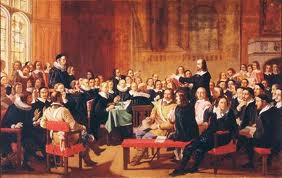
It was 1662 and things were changing in New England. The traditional Puritan society, with its strong emphasis on the Bible and God-fearing life, was in decline and instead a materialistic society was emerging in its place. The Puritan’s children were striving after money and worldly possessions and were drifting away from the faith of their parents. The Puritan leaders, desperate to maintain the Church’s power in the New England government came up with the idea of the Half-Way Covenant. Originally, church membership was strictly for the elect only but the Half-Way Covenant opened church membership to whoever wanted to join the church.
In an attempt to retain their power and influence, the Puritan church of 1662 (the year that Half-Way Covenants were enacted) was willing to sacrifice its internal integrity and turn to compromise.
To some degree the same is happening in America today. Churches draw in crowds at the expense of sound doctrine and true discipleship. In an attempt to draw in the crowds and maintain their influence churches nowadays may compromise their values and their principles to appeal to a greater audience.
This initiative led to a decrease in Puritan piety and church influence, the very thing it had been established to maintain. This set the stage for the First Great Awakening of the early 1700s. Men like Jonathan Edwards and George Whitefield defied the haphazard, half-hearted views of the Half-Way Covenant and stressed personal conversion and salvation.
Jonathan Edwards said, “He that has doctrinal knowledge and speculation only, without affection, never is engaged in the business of religion.” One must know Christ personally to be truly considered saved, something the Puritans understood but chose to forget.
